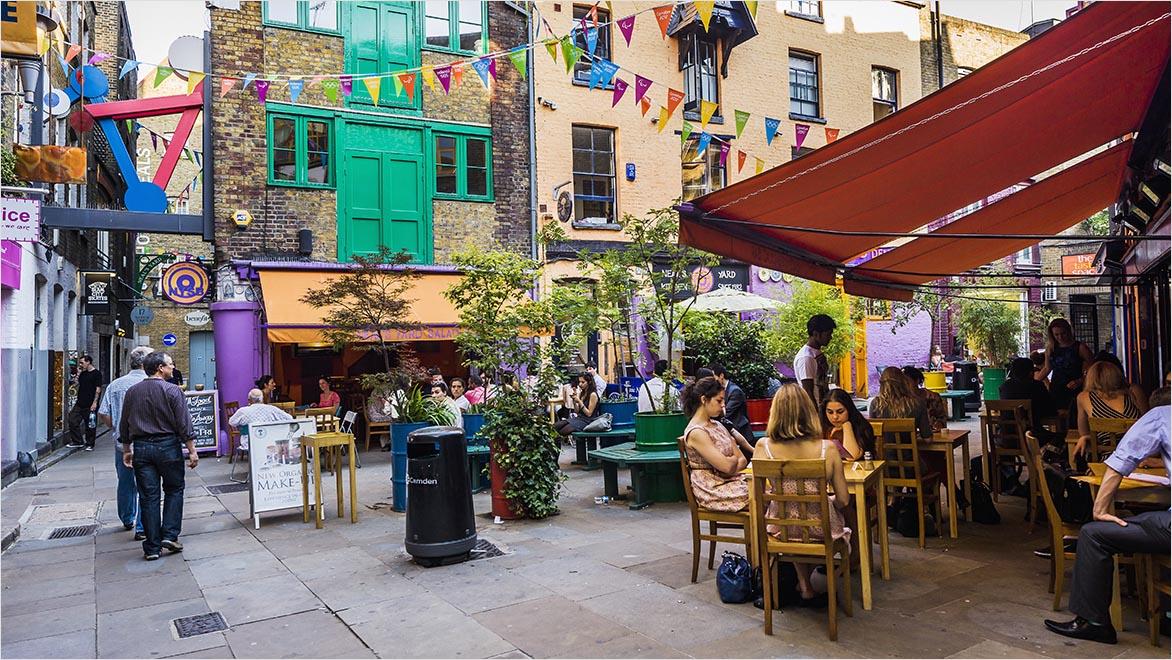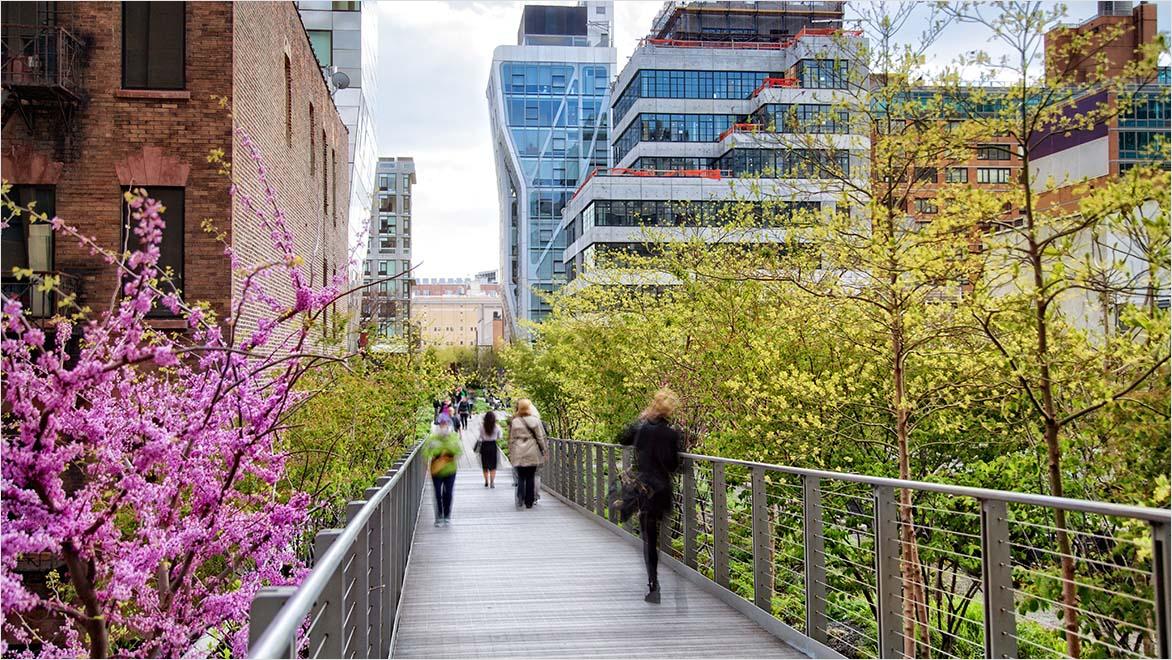& Construction

Integrated BIM tools, including Revit, AutoCAD, and Civil 3D
& Manufacturing

Professional CAD/CAM tools built on Inventor and AutoCAD
Placemaking creates spaces that encourage social interaction.
Placemaking is the process of intentionally creating spaces that encourage social interaction, foster a sense of community, and promote well-being. The goal of placemaking is to transform public spaces or areas within a community to make them more functional, attractive, and engaging for the people who use them. As a result, placemaking requires collaboration among urban planners, architects, and community members to reimagine public places and improve quality of life for residents and visitors.
Urban placemaking includes mixed-use spaces like waterfronts.
Placemaking as a concept in community design took off in the 1960s when urbanist writers like Jane Jacobs (The Death and Life of Great American Cities) and William H. Whyte (The Social Life of Small Urban Spaces) began advocating for walkable, community-friendly urban design catering to people instead of cars and commerce. To sum up this philosophy in architect Jan Gehl’s words, placemaking emphasizes “life [first], then spaces, then buildings,” noting that “the other way around never works.”
By the 1970s, placemaking had begun to go mainstream among landscape architects and urban planners in the
process of creating mixed-use spaces—think squares, parks, pedestrian-friendly streets, and waterfronts—designed to attract people because they are pleasurable or interesting.
Placemaking takes a social approach to building urban infrastructure, looking to cultivate a sense of community, forge stronger cultural and economic bonds between locals, and choose sustainable designs that stand the test of time. Over the years, it evolved from top-down approaches to more participatory methods, giving voice to diverse communities to create spaces that reflect their needs and aspirations.
A goal of placemaking is integrating sustainable features.
The big-picture goal of community placemaking is environment design that creates an atmosphere where it’s easier and more natural to form connections with both residents and visitors. Whether urban or rural, placemaking is a community-informed design process that emphasizes the goals below. (Compare these to the economics of real estate development, where the emphasis is on a return on financial investment.)
Community engagement: Actively involve community members in the planning and design process to ensure that the space reflects their needs and aspirations and fosters a sense of ownership.
Inclusivity and accessibility: Design spaces that cater to users across various demographics and of different ages, abilities, and backgrounds.
Cultural identity: Highlight the cultural heritage and identity of the community by incorporating art, symbols, and local traditions in the space that resonate with the community.
Functional design: Create spaces that serve various purposes and activities—gatherings, recreation, and daily use.
Green and sustainable features: Integrate greenery, sustainable materials, eco-friendly infrastructure, renewable energy, water conservation systems, and other features that minimize environmental impact.
Safety and comfort: Ensure a safe and comfortable environment for all users by implementing proper lighting, seating, and security measures.
Interactive spaces: Map out communal areas, gathering spots, and play areas that encourage social interaction.
Adaptability and evolution: Make flexible design choices that can adapt to the community’s changing needs.
The community placemaking process requires designers, community stakeholders, and local authorities working together every step of the way. It starts with comprehensive research to discover what the community wants, followed by iterative design, implementation, and ongoing evaluation.
Placemaking promotes inclusivity by involving diverse voices in planning and design processes and creating spaces that cater to a range of demographics. Additional benefits include:
Accessible green spaces, walkable areas, and recreational facilities created through placemaking contribute to improved physical and mental well-being. Residents enjoy healthier lifestyles and a better quality of life.
Eco-friendly elements like green infrastructure, renewable energy, and sustainable materials rolled out community-wide can drastically decrease the individual carbon footprints of thousands or even millions of locals, steering them to climate-conscious options like driving less, walking more, biking, and other changes.
Well-designed and vibrant spaces attract businesses, tourists, and investors, leading to increased economic activity. Enhanced property values and commercial opportunities benefit locals and entrepreneurs.
Rural placemaking efforts often honor and celebrate local cultures, traditions, and histories. This preserves the unique identity of communities, instilling pride and a sense of heritage among residents.
Placemaking often considers improvements to transportation infrastructure, making spaces more accessible to pedestrians, cyclists, and public transit users. This effort can reduce reliance on private cars and improve overall mobility.
Plan, design, construct, and manage buildings with powerful tools for Building Information Modeling.
Powerful BIM and CAD tools for designers, engineers, and contractors, including Revit, AutoCAD, Civil 3D, Autodesk Forma, and more
This masterclass from Autodesk University explores how decisions (and non-decisions, apparently) made in developing public spaces can create or destroy value—socially, environmentally, and economically.
The aftermath of the pandemic has impacted peoples’ relationship with the built environment and highlighted low-hanging fruit to improve—including adjusting social priorities (like converting unused offices into housing), creating spaces that support health and well-being, and embracing climate-friendly innovations in construction.
How does a world-famous city transform its approach to public infrastructure, from cultivating a picture-perfect facade to creating experiences residents and visitors can savor at their own pace?
Placemaking encompasses a comprehensive approach to designing and revitalizing public spaces, involving physical, social, and cultural elements. Central to placemaking is active community engagement, ensuring that the local population plays a pivotal role in decision-making.
The physical design emphasizes aesthetics, accessibility, safety, and adaptability, fostering an environment accommodating diverse needs. Cultural identity and heritage are integrated through public art and expressions of local history. Programming and activities bring people together, contributing to a vibrant atmosphere. Connectivity,sustainability, mixed-use development, and effective governance further enhance the success of placemaking, creating dynamic and inclusive spaces that improve community well-being.
The theory of placemaking centers on the belief that the design and development of public spaces should prioritize community well-being and advocates for a holistic approach involving active community engagement to ensure spaces reflect local aspirations.
Placemaking emphasizes multifunctionality, accommodating diverse activities and uses to create dynamic and adaptable environments. Cultural and historical relevance are integral, emphasizing preserving and celebrating local identity through public art and design. Activation and programming promote social interaction, while accessibility and connectivity prioritize inclusivity. Sustainability, adaptive governance, and ongoing feedback underscore the theory.
Placemaking is paramount as it plays a pivotal role in enhancing the well-being of communities. Placemaking contributes to social cohesion, community engagement, and a sense of belonging by focusing on the design and activation of public spaces. The economic impact is substantial, attracting businesses and investments while fostering environmental sustainability through thoughtful design.
Placemaking preserves and celebrates local culture and heritage, creating spaces that reflect a community's identity. Additionally, it promotes safety, supports educational and recreational activities, and contributes to urban resilience.
Placemaking can be categorized into four main types: community-led placemaking, where residents actively participate in shaping and implementing initiatives, emphasizing community identity; market-driven placemaking, led by private developers or businesses to create economically successful and commercially viable spaces; government-led placemaking, in which government agencies take the lead in planning and developing public spaces to meet broader urban planning goals; and institutional placemaking, where institutions like universities or cultural organizations spearhead initiatives aligned with their missions.
A notable example of placemaking is the transformation of New York City's High Line, an elevated historic freight rail line turned into a public park on Manhattan's West Side. The project repurposed an abandoned space into a linear park featuring greenery, walking paths, seating areas, and public art installations.
The High Line is celebrated for its innovative approach to urban design, combining nature with an urban environment. It has become a popular and distinctive public space for residents and visitors. The success of the High Line demonstrates how placemaking initiatives can revitalize underutilized areas.
Digital placemaking refers to integrating digital technologies into the design and experience of public spaces; unlike traditional placemaking, which focuses solely on physical aspects, digital placemaking leverages interactive displays, augmented reality, virtual reality, and other technological elements to enhance the qualities of a place.
This concept involves the use of digital tools to engage communities, foster connectivity, and create dynamic and interactive public spaces. Examples include interactive installations, smart infrastructure, digital art, and mobile applications that contribute to a location's overall atmosphere and user experience, blending the physical and digital realms in modern urban environments.
Rural placemaking involves the intentional and community-driven efforts to enhance public spaces in rural areas, aiming to improve the quality of life for residents and promote community engagement. Unlike urban placemaking, which often focuses on densely populated city centers, rural placemaking addresses smaller towns and villages' unique needs and characteristics.
This approach encompasses initiatives such as community gardens, farmers' markets, public art installations, and recreational areas. By fostering economic development, preserving local culture and heritage, and involving residents in the planning process, rural placemaking contributes to the overall well-being and vibrancy of rural communities.
In urban design, placemaking is a deliberate and collaborative approach to shaping public spaces within cities. It involves the thoughtful planning, design, and management of these spaces with a focus on creating dynamic, inclusive, and culturally rich environments. Placemaking goes beyond traditional urban planning by actively engaging the community in the process, incorporating local identity, and fostering a sense of community ownership. The goal is to develop public spaces that not only enhance the physical environment but also encourage social interaction, cultural expression, and community engagement.


